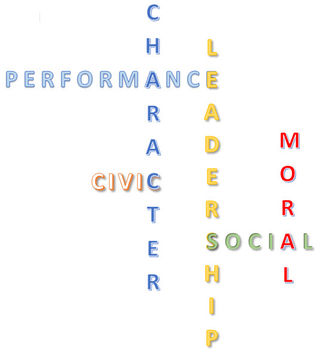Leadership
On Teaching and Developing Character
A systematic approach to cultivating positive traits.
Posted May 27, 2018
To paraphrase “A Tale of Two Cities,” when it comes to character these seem like both the best of times and the worst of times. On the negative side, it seems like some new political, social, or business scandal is uncovered in every news cycle. Media sources keep score on the number of lies politicians tell. Elected officials are accused of personal misconduct. Corporations cheat customers out of millions of dollars. Powerful people (mostly men) are reported to have engaged in sexual harassment or worse. We hardly raise our eyebrows when a famous and previously well regarded person is suddenly disgraced by failures tied to poor character. A person can’t be blamed for concluding that character is on the decline in the United States. On the other hand, social justice movements have emerged in angry response to these violations of acceptable norms of conduct. With instant access to social and news media, people are instantly aware of the actions of transgressors. And, much more quietly, a science of character development has emerged over the past two decades, providing an evidence-based approach to cultivating and developing positive character.
Too often, schools, institutions of higher learning, and other organizations hope for good character among their students and employees, but have no systematic plan to develop it. They hope that they admit or hire people of high character, and they may expunge people who display egregiously poor character by expelling or firing them, but little more thought is given to how to nurture positive character. The approach is essentially Darwinian, a sort of “survival of the fittest” in the best of circumstances. It is clear that this passive approach to character does not work. Institutions may indeed purge the worst of the worst from their ranks, but more mundane violations of good character most often do not result in removal from the organization, and cumulatively contribute to a dysfunctional organizational climate. In turn, this may result in personal and organizational failures of the sort mentioned above.
One of the common truisms used in the U.S. Army is that “hope is not a plan.” And when it comes to character, the Army is now officially codifying a doctrine on what defines good character and how good character may be systematically developed among the hundreds of thousands of soldiers and civilians that make up its ranks. The idea that character is central to maintaining positive morale and organizational climate is not new, but as the nature of warfare has shifted from large scale, industrial-age war (World War II is an example), to smaller and more distributed wars against political and/or ideological entities rather than nations (the worldwide fight against ISIS, for example), our understanding of human thinking, emotions, and character becomes ever more important in influencing who wins and who loses. So when soldiers display poor character by lying, cheating, or stealing from people whom they are nominally there to protect from ISIS or other aggressors, substantial damage to the military operation and the national agenda occurs. This is especially true in the 21st century, where such transgressions are captured and shared on social media in nearly real-time, and are easily exploited by the opposing forces for their own political and social gain.
An exemplar of the Army’s approach to character development is West Point’s Leader Development System (WPLDS). For many years, West Point touted three basic goals for cadet development — academic, military, and physical fitness. The entire curriculum and training plan was based on these three components of officership. Under the leadership of its 59th Superintendent, Lieutenant General Robert Caslen, West Point added character development as the fourth component of cadet development. The goals of WPLDS are for graduates to:
1. Live honorably and build trust.
2. Demonstrate intellectual, military and physical competence.
3. Develop, lead, and inspire.
4. Think critically and creatively.
5. Make sound and timely decisions.
6. Communicate and interact effectively.
7. Seek balance, be resilient, and demonstrate a strong winning spirit.
8. Pursue excellence and continue to grow.
Positive character is seen as a necessary component for achieving each of these goals. Specifically, WPLDS specifies five character attributes necessary to being an effective leader. These are moral (internalization of Army values: loyalty, duty, respect, selfless service, honor, integrity, and personal courage), performance (sense of duty, resilience, and grit), civic (empathy, loyalty, respect, and humility), leadership (inspiring, influencing, and developing others), and social (the ability to act with professional decorum).

West Point’s character development approach is rooted in the “Big Three” strategies identified in the development literature.[i] These are (1) positive and sustained mentoring, (2) skill building curricula, and (3) leadership opportunities. West Point systemically integrates all three of these factors into its cadet development efforts. From the time a new cadet arrives to begin his or her 47 months of education and training, until the day he or she graduates and is commissioned as an officer in the Army, cadets are immersed in carefully designed experiences that optimize character growth. In the classroom, during military training, and on the fields of athletic competition teachers, trainers, and coaches work to promote and reward character that is consistent with the WPLDS model. Project Arete, described in one of my previous Psychology Today posts, is part of a large-scale empirical validation of the West Point Leader Development System. A growing body of evidence shows that high character is indeed associated with academic, military, and physical fitness success at West Point.[ii]
This emphasis on character is not unique to West Point. It is found at other service academies and, more and more, at other non-military educational institutions. Positive psychologist Martin Seligman describes the hunger for positive character education in his recent book, The Hope Circuit.[iii] Importantly, Seligman includes a thorough description of empirical evidence that supports the effectiveness of these character development efforts.
Returning to the “Tale of Two Cities” theme, I am encouraged by the response of people who will no longer stand for widespread character failures that impact our trust in government, individual leaders, or of corporations and other institutions. Hope, indeed, is not a plan. But outrage must be followed by systematic action. There is much that other institutions may learn from military psychologists on how to systematically design strategies to develop, promote, and sustain good character. This may prove to be one of the most exciting and impactful applications of psychological science in the coming years.
Note: The views expressed herein are those of the author and do not reflect the position of the United States Military Academy, the Department of the Army, or the Department of Defense.
[i] Lerner, R. M., Lerner, J. V., Lewin-Bizan, S., Bowers, E. P., Boyd, M. J., Mueller, M. K., et al. (2011). Positive Youth Development: Processes, Programs, and Problematics. Journal of Youth Development, 6(3), 40–64.
[ii] Refer to Chapter 2, “The Right Soldier for the Right Job” in Matthews, M. D. (2014), Head Strong: How Psychology is Revolutionizing War (New York: Oxford University Press).
[iii] Seligman, M. E. P., (2018), The Hope Circuit: A Psychologist's Journey from Helplessness to Optimism (New York: Hachette).




